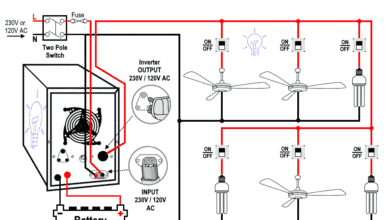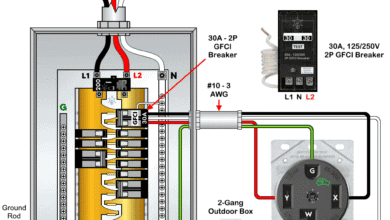Why Do We Need a GFCI & How Does it Protect During Faults?
Why Do We Need a GFCI Breaker and How Does it Protect During Ground Faults?
A Ground Fault Circuit Interrupter (GFCI) is designed to protect circuits by detecting electrical faults that could lead to electric shock. Unlike regular circuit breakers, which only guard against overloads and short circuits, a GFCI detects ground faults involving leakage currents or improper grounding.
GFCIs are used instead of standard breakers in specific areas, especially where the risk of electric shock is higher, such as bathrooms, kitchens, and outdoor spaces. Here’s a detailed look at why GFCIs are essential and how they protect against ground faults.
Related Posts:
- How Do GFCI and Standard Breakers Respond to Ground Faults?
- Why Doesn’t a Standard Breaker Protract Against Ground Faults?
Protection Against Ground Faults:
A ground fault occurs when electricity unintentionally flows from a live wire to a grounded surface, such as a person or equipment, which can result in a dangerous shock. GFCIs detect even tiny differences in current (as little as 4-6 milliamps) between the hot (live) and neutral wires. When such a difference is detected, it indicates current leakage to ground (possibly through a person), and the GFCI instantly shuts off power, usually within 1/40th of a second.
Types of Ground Faults:
GFCIs protect against different types of ground faults, such as:
- Leakage currents (minor faults)
- Faults in wet environments
- Equipment malfunctions due to insulation failure
Common situations where GFCIs protect both appliances and personnel include:
- Contact between the hot wire and a device’s metallic body
- Loss of the neutral connection in the main panel
- Short circuits in the absence of a neutral
- No ground wire connection (e.g., two-prong appliances and wiring in older homes)
How Does a GFCI Protects During Ground Faults:
While a GFCI can respond to short circuits similarly to a standard breaker, its primary purpose is to protect against ground faults. These occur when electrical current unintentionally leaves the intended circuit and flows through an unintended path, typically to ground.
Click image or open in new tab to enlarge
Example:
Imagine you’re using a hairdryer in a bathroom. If water splashes onto the hairdryer and causes a small current to leak from the live wire to the metal casing, and you touch it, the current may flow through you to the ground. Similarly, if the Neutral is lost in the main panel, the fault current will flow through the ground conductor to the main source. The GFCI detects this and quickly cuts off the power, protecting you from a potentially dangerous shock. Keep in mind that ordinary breaker won’t protect against the ground faults.
Imagine using a hairdryer in a bathroom. If water splashes onto it, causing current to leak from the live wire to the metal casing, and you touch it, current could flow through you to the ground. Similarly, If the neutral is lost in the main panel, fault current may flow through the ground conductor to the source. Same is the case in two-wires system where ground is absent at all such as in the older premises. The GFCI detects this and quickly cuts power, protecting you from a potentially dangerous shock. Regular breakers do not offer this protection.
How it Works:
The GFCI monitors the current flowing into the circuit through the hot (live) wire and compares it with the current returning through the neutral wire. If there is even a small imbalance (typically greater than 4-6 milliamps), the GFCI assumes that current is escaping to ground and immediately trips the circuit, cutting off power to prevent harm.
- Related Post: How Does a Standard Breaker Respond to Electrical Fault?
GFCI’s Operation in the Circuit During Normal and Fault Conditions
Normal Circuit Operation
In the following example, a lighting circuit is supplied by single-phase 120V from a 120V/240V source and is protected by a GFCI breaker. Since there are no short circuits, overloads, or ground faults, the same amount of current flows through both the hot and neutral wires, allowing the circuit to operate normally and the light bulb to stay illuminated.
Click image or open in new tab to enlarge
Ground Fault Condition
Now, let’s consider a ground fault scenario where the hot wire accidentally contacts the metallic bulb holder. The return current will then flow back to the main panel through the ground wire instead of the neutral. The GFCI detects this leakage current and responds as follows.
Click image or open in new tab to enlarge
The GFCI senses the imbalance between the hot and neutral wires as high current in the hot wire but none in the neutral. Consequently, it trips immediately to prevent shock hazards from the fault.
Click image or open in new tab to enlarge
Lost Neutral & Ground Fault
Next, imagine a more serious ground fault where the neutral is lost in the main panel. In this case, the GFCI detects a current difference because 2 amps are flowing through the hot wire while the neutral shows 0 amps due to the missing connection. The GFCI again trips immediately to ensure safety.
Click image or open in new tab to enlarge
If both faults occur simultaneously i.e., a lost neutral and a ground fault, the GFCI breaker will still detect the 0-Amp current in the neutral and compare with the huge current flowing in the hot wire. Consequently, it will act immediately, tripping the circuit from the main power supply to ensure safety and protection.
Two-Wire Systems – No Ground Wire
In older homes that use two-wire systems without grounding, GFCIs are particularly important. While these systems may lack a dedicated ground wire, a GFCI can still provide critical protection by detecting ground faults, making it a valuable safety feature in homes without modern wiring.
Click image or open in new tab to enlarge
If a fault occurs in a two-prong outlet (which doesn’t have a ground wire) and an appliance’s casing becomes live, the GFCI will still detect the imbalance in current and cut the power, reducing the risk of shock.
Related Posts:
- Why are Neutral and Ground Wires Separated in a Subpanel?
- Why Must Neutral and Ground Wires Be Bonded in the Main Panel?
- What Happens if the Neutral is Lost in the Main or Subpanel?
GFCI vs. Standard Breaker
While simple circuit breakers protect against overloads and short circuits, they do not protect against ground faults or electric shocks. GFCIs, however, provide critical shock protection by detecting ground faults and stopping the flow of electricity immediately. Their use in moisture-prone or high-risk areas is required by the NEC to prevent accidents and enhance safety.
In all these fault scenarios, the unintended current paths especially through a person or water, are extremely dangerous. Regular circuit breakers can’t detect small leaks of current because they’re designed to trip only when the total current exceeds a specific limit, which protects wiring but not people. GFCIs ensures the safety by detecting current leakage and grounding issues that would otherwise go unnoticed.
Due to the importance of proper protection against the risks associated with ground faults, as discussed above, a GFCI breaker is used instead of a standard circuit breaker. For more details with circuit diagram and pictorial views, refer to the previous article “How Do GFCI and Standard Breakers Respond Differently to Ground Faults?”
Importance of GFCI:
- Prevention of Electric Shocks: GFCIs are vital in protecting individuals from electric shock, especially in wet or damp environments where the risk is higher.
- Compliance with Electrical Codes: The National Electrical Code (NEC) mandates the use of GFCIs in specific areas such as bathrooms, kitchens, garages, outdoor areas, and near water sources to enhance safety.
- Increased Safety: In environments like construction sites or industrial settings, where electric equipment is more likely to come in contact with water, GFCIs provide crucial protection for workers.
Applications of GFCI:
According to National Electrical Code (NEC) Article 210.8, GFCIs are required in:
- Bathrooms
- Kitchens (countertops)
- Outdoors
- Garages
- Crawl spaces and basements
- Laundry areas
- Pool areas or other wet locations
Resources & Tutorials:
- National Electrical Code (NEC) Requirements for Panelboards
- How to Find the Right Wire Size for 100A Service 120V/240V Panel?
- How to Determine the Right Size Capacity of a Subpanel?
- How to Wire a Subpanel? Main Lug Installation for 120V/240V
- How to Determine the Number of Circuit Breakers in a Panel Board?
- How to Size a Load Center, Panelboards and Distribution Board?
- How to Wire 120V & 240V Main Panel? Breaker Box Installation
- How to Wire a GFCI Circuit Breaker?
- How to Wire and Install an Electrical Outlet Receptacle?
- How to Wire a GFCI Outlet?
- How to Wire GFCI Combo Switch and Outlet
- What Happens When You Touch an Electrical Busbar?
- Can the Neutral Wire Cause Electric Shock? Different Cases
- Difference Between Grounding, Earthing and Bonding
- Difference Between Neutral, Ground and Earth?
- Will I Get an Electric Shock If I Touch the Ground Wire?
- Will a Man Get an Electric Shock If He Hangs on a Live Wire?
- Difference Between Circuit Breaker and GFCI
- Tripping Curves of Circuit Breakers – B, C, D, K and Z Trip Curve













